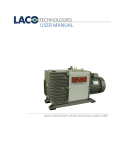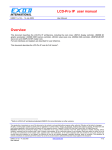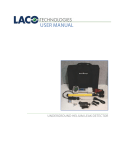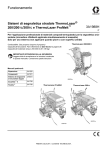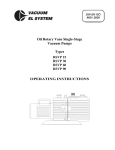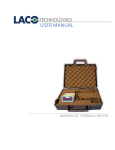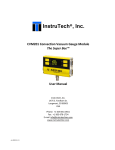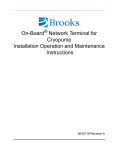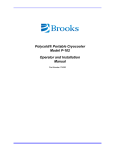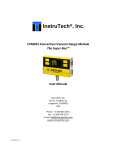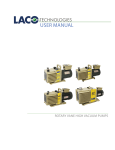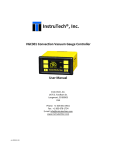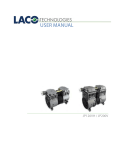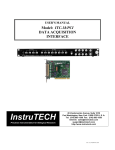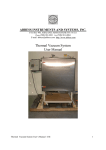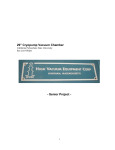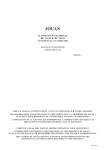Download USER MANUAL - LACO Technologies, Inc.
Transcript
USER MANUAL VACUUM DEGASSING CHAMBERS AND SYSTEMS CONTACT US PHONE/FAX Toll Free: 800.465.1004 Phone: 801.486.1004 Fax: 801.486.1007 ADDRESS LACO Technologies, Inc. 3085 West Directors Row Salt Lake City, UT 84104 WEB www.lacotech.com [email protected] SMT-09-1002 RevB1 ii © 2014 LACO TECHNOLOGIES, INC. CONTENTS 1.SCOPE................................................................................ 1 2.SAFETY.............................................................................. 1 3.COMPONENTS.................................................................. 1 4.BASIC OPERATION....................................................................... 3 5. RECOMMENDED PROCEDURES................................... 4 6. APPENDIX A: REMOVAL OF AIR FROM LIQUIDS................................ 5 7. APPENDIX B: CARING FOR ACRYLIC.................................................... 8 8. APPENDIX C: SPARE PARTS AND ACCESSORIES................................ 9 9. APPENDIX D: W2V40 ROTARY VANE HIGH VACUUM PUMP USER MANUAL................................................... 13 16. APPENDIX E: INSTRUTECH STINGER™ CONVECTION VACUUM GAUGE MODULE USER MANUAL............. 26 22. ANALOG OUTPUT.......................................................... 42 24. FACTORY SERVICE AND SUPPORT............................ 51 25.WARRANTY..................................................................... 51 iii © 2014 LACO TECHNOLOGIES, INC. LACO USER MANUAL - VACUUM DEGASSING CHAMBERS AND SYSTEMS 1. SCOPE This manual outlines the components, safety information, recommended maintenance for LACO Technologies Vacuum Degassing Systems. Following these recommended procedures will ensure that your degassing system is performing at its highest level. This manual also includes product information for degassing systems, including accessories, options, and spare parts. 1.1 MAKEUP OF A DEGASSING SYSTEM A typical vacuum degassing systems includes a vacuum chamber connected to a vacuum pump for removing trapped gases from compounds. With the appropriate vacuum pump degas chambers are used to reduce the pressure above the surface of the material and permit escape and subsequent removal of entrapped air and other gases that could induce failure of the final product. Degas chambers and pumps are available with several options and accessories for a complete vacuum degas system to meet your requirements. 2. SAFETY 2.1 VACUUM PUMP SAFETY A complete manual will be provided for the vacuum pump and should be referred to for safety issues relating to the specific vacuum pump purchased. 2.2 VACUUM CHAMBER SAFETY All degassing chambers are designed for holding full vacuum, but any defects, cracks or severe wear should be reported to LACO for advisement. Vacuum chambers are not designed for pressure applications. If slight pressure is needed (5 psi or less) the chamber must be provided with necessary clamps and pressure safety relief valves. 3. COMPONENTS A vacuum degassing system comprises of two main items; a vacuum chamber and vacuum pump. Several accessories and options can be added to customize the degassing system. Systems are available in modular configurations or as complete setups mounted onto carts or stands. 1 © 2014 LACO TECHNOLOGIES, INC. LACO USER MANUAL - VACUUM DEGASSING CHAMBERS AND SYSTEMS 3.1 VACUUM CHAMBERS The most common vacuum degassing chamber is a cylindrical vessel, fitted with a vacuum control valve, vacuum release valve, vacuum dial gauge, "L" type gasket and a clear acrylic or metal lid. The cost of cylindrical vacuum chambers tend to increase far more with increases in diameter than length. Horizontal chambers will also be more than corresponding vertical chamber due to the need for cradle supports and lid hinging. This orientation is preferred if the product is easier to load and monitor. A common option for horizontal chambers include shelf support rails and removable shelves. Vacuum degas chambers are most commonly made from 304 stainless steel however LACO offers vertical chambers also in aluminum and clear acrylic for full viewing. To select a chamber for your purpose, ensure that your container will fit into the chamber with sufficient space to allow for expansion of the liquid to be degassed. Initially, fill your container one quarter with mixture, experience will show the limit of mixture level permissible. 3.2 VACUUM PUMP AND HOSE Based on the application the vacuum pump can be the greatest cost and the most critical component for successful degassing. Choices range from dry membrane pumps capable of vacuum levels down to 60 Torr or 27 inHG for single stage models and 7 Torr or 29 inHG for two stage models. These dry pumps have pumping speeds or cfm values ranging from 1 to 7 cfm. For higher vacuum levels and cfm values, oil sealed rotary vane vacuum pumps are used. Single stage models are capable of vacuum down to 0.5 Torr and cfm from 1 to 100 cfm. Two stage models are capable of vacuum down to 0.005 Torr or 5 millitorr and range in cfm from 2 to 50 cfm. When selecting a pump it is necessary fully degas the mixture before it even begins to gel or set. Knowing the pot life of the material will help in selecting the right speed or cfm of pump. The manufacturer of the material may recommend a vacuum level based on the properties of the material. If you are unsure of the vacuum level requirement it is always easier to have more vacuum than less. 3.3 COMMON ACCESSORIES • Vacuum traps protect the vacuum pump from contaminates during the degassing process and also prevent backstreaming of pump oil into the vacuum lines or chamber. • Digital vacuum gauges with units in torr or millitorr to accurately monitor and repeat the process at the same vacuum level. • Chamber mixers with rotary shaft feedthroughs 2 © 2014 LACO TECHNOLOGIES, INC. LACO USER MANUAL - VACUUM DEGASSING CHAMBERS AND SYSTEMS • Chamber internal platen heaters • Heating blankets can be fitted around the vacuum chamber to achieve higher wall temperatures. Heaters are NOT suitable for use with clear acrylic doors. • Electrical and thermocouple feedthroughs • Liquid feedthroughs and valves 4. BASIC OPERATION Degassing of a liquid mixture is the removal of air bubbles which become entrapped in the mixture when mixing the components. See Appendix A for a complete discussion on vacuum degassing. The following is a quick review of procedures for removal of air bubbles from resin mixes, RTV silicone and similar liquids. 1. Close the vacuum valve connected to the vacuum pump and switch the vacuum pump ON and allow to warm up. 2. Open the vacuum release or vent valve and remove the chamber lid. 3. Mix the materials to be degassed in a suitable container not more that 1/3 to 1/2 full and place this container in the chamber. 4. Replace the lid, making sure it fully covers the gasket on the vacuum chamber. 5. Close the vacuum release valve. 6. Open the vacuum valve. 7. Watch the mixture and the vacuum gauge. When the chamber is undergoing the evacuation the mixture will begin to rise, slowly at first. At nearly full vacuum the mixture will have swollen up to fill the mixing vessel, air bubbles will appear and burst at the mixture surface. After a few seconds, this mixture will collapse to near its original volume. Occasional bubbles will appear at the surface. 8. If the mixture rises too fast and is likely to overflow the container then momentarily reduce the vacuum by opening and closing the vacuum release valve or closing the vacuum valve. Repeat if necessary. 9. Wait for about 30 seconds after the collapse and close the vacuum valve. 3 © 2014 LACO TECHNOLOGIES, INC. LACO USER MANUAL - VACUUM DEGASSING CHAMBERS AND SYSTEMS NOTE One can also monitor the time and vacuum level on the vacuum gauge as well as the material, to determine the length of time to hold it under vacuum. The length of time to degas is highly dependent on the product and the particular application. Often an absolute pressure vacuum gauge is used to monitor the vacuum level of the system and determine if gases or solvents are evolving from the product. The vacuum chambers are equipped with a relative 0-30 in HG vacuum gauge, which is mainly used to determine a rough vacuum level. For more accurate measurement and control of the process, contact LACO about an absolute vacuum gauge. 10. Open the vacuum release valve and remove the lid. 11. Fill the mold(s) carefully to minimize trapped air. 12. If necessary, place the mold(s) into the vacuum chamber. 13. Repeat stages above as necessary. 14. Some bubble may appear at the mixture surface and burst. 15. Continue degassing for about 30 seconds at full vacuum. 16. Repeat steps 10, 11, 12. 5. RECOMMENDED PROCEDURES 5.1 VACUUM PUMP OIL CHANGES The vacuum pump is the most critical maintenance item in a degassing system. For oil sealed rotary vane vacuum pumps the most critical maintenance item is to change the pump oil frequently. The frequency will depend on the application and usage but it is recommend that if the oil ever turns cloudy, dark or is foul smelling, change it immediately. Any degassed solvents, water or other liquids will condense in the pump oil and lower the vacuum level the pump is able to achieve. Frequent oil changes will also extend the life of the vacuum pump. When changing pump oil it is recommended to also use a flushing fluid to cleanse the pump. LACO’s LVOFF is a hydrocarbon fluid specifically designed to assist in the internal cleaning of particles and sludge build-up in mechanical vacuum pumps. Its low viscosity helps free contamination from internal parts allowing it to be flushed from the pump through the drain valve. 4 © 2014 LACO TECHNOLOGIES, INC. LACO USER MANUAL - VACUUM DEGASSING CHAMBERS AND SYSTEMS 5.2 FLUSHING PROCEDURE 1. Drain the used fluid from the pump while still hot from operation and refill with LVOFF. 2. Run the pump blanked off or isolated for approximately 20-30 minutes or until pump is hot. 3. Drain the pump completely (open gas ballast and jog the pump to aid in removing oil). 4. Repeat the procedure if necessary then refill with LACO 19 grade oil for direct drive pumps of 195 grade for belt drive pumps or other oil as specified. WARNING Any foreign material left remaining in the vacuum chamber or vacuum hose lines can contribute to outgassing and reduce the performance of the system and the vacuum pump. 6. APPENDIX A: REMOVAL OF AIR FROM LIQUIDS 6.1 APPLICATIONS • RTV Silicone Rubber • Araldite • Polyester Resin • Plastasols • Casting Plaster • Polysulphide Rubber • Polyurethane Resin • Adhesive Mixes • Epoxy Resins • Investment Plaster 6.2 INTRODUCTION When any of the above listed materials are mixed with the required additives, accelerator, filler etc., then air bubbles can become trapped within the mixture. If not removed before the material cures the air bubbles can cause defects such as nodules, cavities, hollows in the finished cast. Sometimes such defects remain out of sight just below the surface only to appear after a period of use. With electrical and electronic encapsulation then these cavities can give rise to electrical breakdown. On art figures cavities or nodules require correcting, which increases the time and costs for a piece. 5 © 2014 LACO TECHNOLOGIES, INC. LACO USER MANUAL - VACUUM DEGASSING CHAMBERS AND SYSTEMS Mixing can be done by hand or an electric mixer before degassing, depending upon the quantities involved. It depends on the amount and type of filler and resin. The components are mixed in a container. It is essential that the resulting mixture behaves as a liquid, i.e., flows and can be poured. When this mixture is put into the vacuum chamber and the air pressure above it reduced, i.e. evacuated, the air bubbles which were formed at atmospheric pressure now expand and rise to the surface where they burst. The air thus released is pumped away. In practice, degassing causes the whole mixture to expand about two to six times its original volume. As the bubbles burst at the surface, the expansion decreases. This process can take up to several minutes depending upon the nature of the mixture, the volume of the vacuum chamber and the speed of the vacuum pump used. After expansion has subsided, bubbles can still appear at the surface, which is mainly caused by the escape of traces of remaining air plus volatile components of the mixture boiling off. The vacuum should only be held for a further 30 seconds to 60 seconds at this stage, otherwise the composition of the mixture will be altered and setting time will change due to volatile components being removed by the vacuum. This degassed mixture is then poured into your mold taking care to minimize any trapped air. When your mold has been filled if you desire you can put the whole mold with mixture into the vacuum chamber and evacuate as before. This time only one or two bubbles should appear from air, which was trapped in undercuts or adhering to the mould surface. Again, beware of boiling off the volatile components, only a few seconds or so at full vacuum should be sufficient. You should be able to complete the above process long before the material begins to gel or increase in viscosity. If degassing is too slow, you may need to either increase the evacuation speed, i.e., change the pump (to a larger cfm) or the decrease chamber size to reduce the pump down time, or decrease the accelerator or possibly keep the components warm in very cold weather. 6.3 COMMON CAUSES OF BUBBLES IN CASTINGS • Air inclusion during mixing the resin and hardener together. • Air trapped in moulds. • Air trapped due to improper casting/moulding techniques. • Air introduced by suction as the material shrinks or due to a leaking tool. • Trapped residual solvent vapors from certain types of mould releases. 6 © 2014 LACO TECHNOLOGIES, INC. LACO USER MANUAL - VACUUM DEGASSING CHAMBERS AND SYSTEMS • Volatile components being stripped out of the materials while casting under vacuum. • Gases generated during the reaction (hardening) process. • Gases formed during improper storage (moisture contamination etc.) • Gases introduced through pressurized systems. • Air from improperly degassed resin and/or hardener. 6.4 FACTORS THAT AFFECT THE REMOVAL OF GASES • VISCOSITY OF THE MIX. The higher the viscosity the more difficult it is to remove gases • SURFACE TENSION OF THE MATERIALS Can be reduced by heating and the addition of surfectants • TEMPERATURE OF THE MIX. Heating the material will reduce the viscosity. Be sure to consider the pot life and gel time before heating any mixed materials. • AMOUNT OF MATERIAL BEING DEGASSED AT ONE TIME. The depth to surface ratio is important. The larger the surface that is exposed to the vacuum the better. The lower the amount of product the rising bubbles have to travel through the better. • AGITATION Agitation (mixing) during the degassing process (while under vacuum) will speed the removal of air. • VACUUM PUMP SIZE The size or pumping speed of your vacuum pump usually noted in terms of cubic feet per minute or cfm as well as the ultimate pressure or vacuum level your pump can achieve. • CHAMBER SIZE AND PIPING Chamber size and the diameter and length of the vacuum hose can also effect the time for removal of gases. It is recommended to use at least the same diameter as your pump inlet and to use the shortest length hose as possible. 6.5 MIXING UNDER VACUUM Some materials need to be mixed under vacuum in order to obtain an air free material. Some materials may also need heating before or during mixing. Such material may need constant agitation or vibration to keep them fluid so that they will actually flow as fluids to fill moulds and containers. In such cases LACO can review the application and recommend suitable vacuum equipment. 7 © 2014 LACO TECHNOLOGIES, INC. LACO USER MANUAL - VACUUM DEGASSING CHAMBERS AND SYSTEMS 6.6 COMPLETION OF PROCESS BY PRESSURE After subjecting the liquid material to a vacuum to remove entrapped air the voids and spaces are probably still present but in vacuum. The final stage of the process is to release the vacuum in the chamber, i.e. admit the atmosphere which exerts a pressure of about 14.7 pounds on every square inch. It is this pressure that pushes the material into the voids undercuts and crevices of the mould. It is essential that the vacuum is released immediately after degassing. It may help to gently vibrate the mould full of material to temporarily overcome any tendency of the material to be thixotropic, i.e., non-flowing such as with certain casting plaster mixes. If the material has already begun to set while in vacuum and the surface is not smooth but sponge like, then upon release of the vacuum air will enter the body of the material and create a gassy cast. Should this happen then vibration under vacuum and during vacuum release is needed so that the material flows in to all the cavities. 7. APPENDIX B: CARING FOR ACRYLIC 7.1 WASHING Wash acrylic with a solution of mild soap or detergent and lukewarm water. Use a clean soft cloth, applying only light pressure. Rinse with clean water and dry by blotting with a damp cloth or chamois. Grease, oil, or tar may be removed with a good grade of hexane, aliphatic naphtha, or kerosene. These solvents may be obtained at a paint or hardware store and should be used in accordance with manufacturer’s recommendations. DO NOT USE: Window cleaning sprays, kitchen scouring compounds or solvents such as acetone, gasoline, benzene, alcohol, carbon tetrachloride, or lacquer thinner. These can scratch the sheet’s surface and/or weaken the sheet causing small surface cracks called "crazing." Acrylic can be cleaned with the following commercial cleaners without damaging the coated surface: Fantastik household cleaner, Formula 409 household cleaner, Glass Plus cleaner, Mr. Clean household cleaner, Top Job household cleaner, and Windex window cleaner. It is not recommended to use abrasive cleaners. 7.2 POLISHING Protect acrylic and maintain its surface gloss by occasional polishing with a good plastic cleaner and polish. Apply a thin, even coat with a soft, clean cloth and polish slightly with cotton flannel. Then wipe with a damp cloth to help eliminate electrostatic charges that can attract dust particles. 8 © 2014 LACO TECHNOLOGIES, INC. LACO USER MANUAL - VACUUM DEGASSING CHAMBERS AND SYSTEMS 7.3 REMOVING SCRATCHES Fine scratches can be removed by hand polishing. Apply a plastic scratch remover to a soft flannel pad and rub. When the scratches have disappeared, remove all residue and polish. For deeper scratches, first sand lightly with a 400-grit "wet or dry" sandpaper, using plenty of water and rinsing the sandpaper frequently. Follow by buffing with a clean muslin wheel and a good polishing compound. For the highest gloss, use a clean-up wheel made of soft cotton or flannel sections and on which no compound is used. An electric drill with a buffing wheel is ideal. 8. APPENDIX C: SPARE PARTS AND ACCESSORIES For information on recommended spare parts and accessories, see the following tables: • Table 1: Element Types for Clear Vacuum Types • Table 2: Vacuum Pump Oil and Grease • Table 3: Oil Mist Eliminators • Table 4: PVC Vacuum Hose with NW Flanges • Table 5: Vacuum Hose Fittings • Table 6: Vacuum Gauges • Table 7: Vacuum Chamber Fittings and Valves • Table 8: Chamber Gaskets • Table 9: Clear Vacuum Traps and Replacement Elements LACO recommends to have one gallon of vacuum pump oil and one gallon of flushing fluid along with a spare chamber lid gasket. Also, silicone vacuum grease is also helpful for lubrication on the lid gasket to ensure quick and easy vacuum sealing. If the chamber is equipped with a filter trap, replacement elements are also recommended. 9 © 2014 LACO TECHNOLOGIES, INC. LACO USER MANUAL - VACUUM DEGASSING CHAMBERS AND SYSTEMS Below is a list of various element types available for the clear vacuum traps. Table 1: Element Types for Clear Vacuum Types ELEMENT TYPE DESCRIPTION Copper Gauze Large surface area traps condensable particles and oil vapors Stainless Steel Gauze Same as copper, but with added corrosion protection Molecular Sieve Reduces mechanical pump backstreaming and traps water vapor Sodasorb® Minimizes migration of corrosive chemicals and neutralizes acidic vapors Activated Charcoal Removes organic vapors Activated Alumina Removes Lewis acids, polar compounds, other acids, water and particles Polypro 2 Micron Traps high volumes of solids and particulates as small as 2 microns; available in three sizes Polypro 5 Micron Same as above Polypro 20 Micron Same as above Table 2: Vacuum Pump Oil and Grease DESCRIPTION 1 QUART 1 GALLON 5 GALLON 19 Grade, Direct Drive, VP1x10-5 Torr LVO191QT LVO191G LVO195G 20 Grade, High Quality, VP 1x10 Torr LVO201QT LVO201G LVO205G Flushing Fluid, All Pumps, Low Viscosity N/A LVOFF1G LVOFF5G Silicone Vacuum Grease LVO9140Z (4 oz Jar) -6 Table 3: Oil Mist Eliminators P/N DESCRIPTION SPARE ELEMENTS LOME20025 Compact, NW25 In, 1/2" Outlet, 10 cfm LGL915 LOME60025 15 cfm Clear Housing Oil Mist Eliminator (NW25) LGL150 LOME30050 5 cfm Compact Oil Mist Eliminator (1/2" NPT) Table 4: PVC Vacuum Hose with NW Flanges P/N SIZE LVFP100N25 LMSA0953 1/2" I.D. LMSA0955 1" I.D. LMSA0986 3/8" I.D. LVFAN16D50A 1/2" I.D. x NW 16 LVFAN16H38A 3/8" I.D. x NW 16 LVFAN25H38A 3/8" I.D. x NW 25 LVFAN25H50A 1/2" I.D. x NW 25 10 © 2014 LACO TECHNOLOGIES, INC. LACO USER MANUAL - VACUUM DEGASSING CHAMBERS AND SYSTEMS P/N SIZE LVFP038 3/8" I.D. LVFP050 1/2" I.D. LVFP100 1" I.D. Table 5: Vacuum Hose Fittings P/N DESCRIPTION LVFCN25A Wing Nut Clamp LVFGN25SV Centering Ring SS/Viton LVFBN25S Blank-Off, SS LVFFLWN25S Flange Long Stub, SS LVFTN25S Tee, SS LVFTX25S Cross, SS LVFE90N25S Elbow, SS LVFAN25FP12S 1/8’ FNPT Adaptor, SS Table 6: Vacuum Gauges P/N DESCRIPTION LVG-3025B 0-30 in HG Vacuum Gauge, SS Case, 1/4" NPT Bottom Mount LVG-3025B 0-30 in HG Vacuum Gauge, SS Case, 1/4" NPT Rear Mount LVG-200TC Digital Thermocouple Display, Sensor & Cable CVM211 Instrutech Stinger™ Convection Vacuum Gauge Module Table 7: Vacuum Chamber Fittings and Valves P/N DESCRIPTION LMSA8001 1/2’ MNPT Adaptor to NW25 - SS LMSA8002 3/4" MNPT Adaptor to NW25- SS LMSA8003 1/4" MNPT x FNPT Mini Ball Valve LMSA8043 1/2" MNPT x FNPT Mini Ball Valve LMSA8005 3/4" FNPT Ball Valve LMSA8006 1/4" NPT Bronze Muffler LMSA8007 1/2" NPT Bronze Muffler Table 8: Chamber Gaskets CHAMBER BUNA LID GASKETS P/N Chamber Diameter LG06B 6" LG08B 8" LG10B 10" LG12.75B 12.75" LG18RB 18" LG24RB 24" 11 © 2014 LACO TECHNOLOGIES, INC. LACO USER MANUAL - VACUUM DEGASSING CHAMBERS AND SYSTEMS Table 9: Clear Vacuum Traps and Replacement Elements P/N DESCRIPTION MV300005 4.5" Clear Trap, No Insert MV300010 9.5" Clear Trap, No Insert MV300100 9.5" Clear Trap, with Copper Gauze MV300105 4.5" Clear Trap, with Copper Gauze MV300200 9.5" Clear Trap, with SS Gauze MV300205 4.5" Clear Trap, with SS Gauze MV300300 9.5" Clear Trap, with Molecular Sieve MV300305 4.5" Clear Trap, with Molecular Sieve MV300400 9.5" Clear Trap, with Sodasorb MV300405 4.5" Clear Trap, with Sodasorb MV300500 9.5" Clear Trap, with Activated Charcoal MV300505 4.5" Clear Trap, with Activated Charcoal MV300600 9.5" ClearTrap, with Activated Alumina MV300605 4.5" Clear Trap, with Activated Alumina MV300610 9.5" Clear Trap, with PolyPro 2 micron MV300615 4.5" Clear Trap, with PolyPro 5 micron MV300620 9.5" Clear Trap, with PolyPro 5 micron MV300625 4.5" Clear Trap, with PolyPro 5 micron MV300630 9.5" Clear Trap, with PolyPro 20micron MV300635 4.5" Clear Sump with PolyPro 20 micron MV300900 Replacement Element, 9.5" Copper Gauze MV300905 Replacement Element, 4.5" Copper Gauze MV300910 Replacement Element, 9.5" Stainless Steel MV300915 Replacement Element, 4.5" Stainless Steel MV300920 Replacement Element, 9.5" Molecular Sieve MV300925 Replacement Element, 4.5" Molecular Sieve MV300930 Replacement Element, 9.5" Sodasorb MV300935 Replacement Element, 4.5" Sodasorb MV300940 Replacement Element, 9.5" Activated Charcoal MV300945 Replacement Element, 4.5" Activated Charcoal MV400910 Replacement Element, 9.5" Activated Alumina MV400915 Replacement Element, 4.5" Activated Alumina MV400920 Replacement Element, 9.5" Polypro 2 MV400925 Replacement Element, 4.5" Polypro 2 MV400930 Replacement Element, 9.5" Polypro 5 MV400935 Replacement Element, 4.5" Polypro 5 MV400940 Replacement Element, 9.5" Polypro 20 MV400945 Replacement Element, 4.5" Polypro 20 LMSA8001 1/2"MNPT Adaptor to NW25 - SS LMSA8002 3/4"MNPT Adaptor to NW25 - SS 12 © 2014 LACO TECHNOLOGIES, INC. LACO USER MANUAL - VACUUM DEGASSING CHAMBERS AND SYSTEMS 9. APPENDIX D: W2V40 ROTARY VANE HIGH VACUUM PUMP USER MANUAL This manual contains installation, operation, maintenance, and troubleshooting information for the W2V40 Rotary Vane Vacuum Pump. Please read the manual in its entirety before operating the pump. Our rotary vane vacuum pumps are designed to ensure safety when used properly. It is the responsibility of the user to follow safety-related warnings, cautions, notes, and other requirements described in this manual. Returned equipment will not be accepted without prior authorization. Prior to shipping please call for a returned material authorization (RMA) number. LACO Technologies reserves the right to cancel the warranty if the pump is disassembled without authorization, if pump fluids are used that are not compatible with the design and materials used in the manufacture of the pump, and if unauthorized spare parts are used. 10. SAFETY Death or serious injury can result from improper use or application of this pump. If the pump will be exposed to toxic, explosive, pyrophoric, highly corrosive, or other hazardous process gases including greater than atmospheric concentrations of oxygen, contact LACO Technologies for specific recommendations. WARNING Ground the motor properly during installation. Disconnect the power before beginning installation, maintenance or repair work or before interchanging the input leads when correcting the direction of rotation. Disconnecting the power also avoids an unexpected start-up for pumps with automatically resetting thermal overloads. WARNING If hazardous gasses or vapors are expelled from the pump, do not operate the pump without an exhaust line and an adequate exhaust system. WARNING Do not exceed a maximum backpressure of 7 psig. Excessive pressure in the pump could damage the seals, blow out the sight glass, or rupture the pump housing. In addition, excessive backpressure can result in hazardous process gas or contaminated oil leaking out of the pump. WARNING Don’t install an exhaust line with a smaller ID than the exhaust port or allow restrictions or deposit build up in the exhaust line. 13 © 2014 LACO TECHNOLOGIES, INC. LACO USER MANUAL - VACUUM DEGASSING CHAMBERS AND SYSTEMS WARNING If you are purging the oil casing with inert gas, limit the inert gas flow to avoid exceeding the 7 psig limit. Accidentally connecting the pump’s exhaust port to a vacuum line containing a closed valve also causes a dangerous excessive pressure. WARNING Hazardous process gases can concentrate in the vacuum pump, its oil, and its filters. If the pump has been used on toxic, explosive, pyrophoric, corrosive, volatile, or other hazardous substances, take the proper safety precautions before opening the pump or filters. Proper precautions could include: —inert gas purging before and after you drain the oil —sweeping hazardous gas from the pump or filters —wearing gloves or protective clothing to avoid skin contact with toxic or highly corrosive substances —using a ventilated work area —employing fume hoods —wearing safety masks —using a breathing apparatus CAUTION LACO rotary vane vacuum pumps are two-stage units designed to operate continuously in the low torr & subtorr (millitorr) pressure range (<10 mmHg). Operation for prolonged periods of time above 10 mm HG (Torr) can result in permanent damage to the pump. 14 © 2014 LACO TECHNOLOGIES, INC. LACO USER MANUAL - VACUUM DEGASSING CHAMBERS AND SYSTEMS 11. SPECIFICATIONS 11.1 BASIC PARTS AND SPECIFICATIONS 11.2 W2V40 SPECIFICATIONS COMPONENT DESCRIPTION Pumping Speed @ 60 Hz 400 l/m, 14 cfm, 24 m3/hr Pumping Speed @ 50 Hz 333 l/m, 11.6 cfm, 20 m3/hr Ultimate Pressure (Gas Ballast Open) 5 x 10-2 Torr Ultimate Pressure (Gas Ballast Closed) 5 x 10-3 Torr Standard Motor, CE Marked 115V, 1 HP, 60 Hz, On/Off Switch Power Connection Junction Box Motor Speed @ 60 Hz 1700 rpm Oil Capacity 1500 cc (1.5 quart) Weight Net 70 lbs, shipping 75 lbs Intake/Exhaust type/diameter NW 25 (26 mm) O.D. tube Ambient Operating Temperature 70° to 40° C (45° to 104° F) 15 © 2014 LACO TECHNOLOGIES, INC. LACO USER MANUAL - VACUUM DEGASSING CHAMBERS AND SYSTEMS 11.2.1 W2V40 DIMENSIONS 11.2.2 W2V40 PUMP CURVE 16 © 2014 LACO TECHNOLOGIES, INC. LACO USER MANUAL - VACUUM DEGASSING CHAMBERS AND SYSTEMS 11.2.3 W2V40 SERVICE KIT CODE # DESCRIPTION QTY REMARKS W2V0020 O-ring G-45 1 Common* W4V0022 Oil Seal (Viton) 1 Common* W2V0021 Oil Seal (Iron) 1 Common* W4V0027 O-ring S-95 1 Common* W4V0028 O-ring G-70 1 Common* W4V0043 O-ring P-6 1 Common* W4V0044 O-ring AN-170 1 Common* W4V0048 O-ring P-5 1 Common* W4V0068 1st Stage Valve 1 Common* W4V0086 2nd Stage Valve 14.5X7 1 Common* W4V0079 Distributor Valve dia 45X2 1 Common* W4V0098 O-ring P-6 1 Common* W4V0094 O-ring P-6 2 Common* W4V0104 Oil Suction Felt 1 Common* W4V0016 O-ring S-75 1 Common* W4V0052 O-ring G-45 1 Common* W4V0034 1st Stage Blade 55X38X6t 2 Major Only W4V0035 1st Stage Blade Spring 0.5X2.5X3.5X45 2 Major Only W4V0036 1st Stage Spring Guide 2.2X3.5X32 2 Major Only W4V0037 2nd Blade Spring Guide 2.2X3.5X32 2 Major Only W4V0038 2nd Stage Blade Spring 0.5X2.5X3.5X45 2 Major Only W4V0039 2nd Stage Blade 40X30.5X6t 2 Major Only W4V0074 2nd Valve Spring 0.6X7.2X17 1 Major Only W4V0081 Oil Pump Blade 6X6X21 1 Major Only Total (minor kit) Total (major kit) *Major and Minor 17 © 2014 LACO TECHNOLOGIES, INC. LACO USER MANUAL - VACUUM DEGASSING CHAMBERS AND SYSTEMS 11.2.4 W2V40 EXPLODED VIEWS 18 © 2014 LACO TECHNOLOGIES, INC. LACO USER MANUAL - VACUUM DEGASSING CHAMBERS AND SYSTEMS 12. PREPARATION & INSTALLATION 12.1 RECEIVING Each rotary vane vacuum pump is inspected and carefully packed prior to shipment. Inspect it after carefully unpacking it. In case of external damage, retain the shipping container and notify the shipping carrier and LACO immediately. The packing materials are designed specifically for the pump, they should always be used when transporting the pump. Unpack the pump and check for shipping damage as follows: 1. Inspect the outside of the shipping container for shipping damage. If you will be making a damage claim, save the shipping container and packing materials. 2. Unpack the pump. 3. Carefully inspect the pump for damage. 4. If you find any damage, proceed as follows: a. Save the shipping container, packing material, and parts for inspection. b. Notify the carrier that made the delivery within 7 days of delivery. c. File a claim with the carrier. d. Contact LACO Technologies to make arrangements for replacing the damaged part(s). 12.2 REPORTING SHIPPING SHORTAGE If you did not receive all the goods that you ordered, do the following: 1. Check the number of items listed on the packing slip. If the number of pieces listed is greater than the number of shipping containers received, contact the carrier concerning the missing piece. 2. Check the packing list to see if the missing item(s) are on back order. 3. Carefully check the packing material and container to ensure the missing item(s) were not overlooked. 4. If you cannot find the item(s), please notify LACO Technologies immediately 12.3 REPORTING INCORRECT SHIPMENT If the item received is not the item ordered, contact LACO Technologies immediately. 19 © 2014 LACO TECHNOLOGIES, INC. LACO USER MANUAL - VACUUM DEGASSING CHAMBERS AND SYSTEMS 12.4 INITIAL FILLING WITH VACUUM PUMP FLUID All our rotary vane vacuum pumps are shipped with a full change of vacuum pump fluid. Always be sure that the oil level is approximately in the middle of the low and high level marks in the sight glass and please note that upon start up of the pump, the oil level in the sight glass will drop slightly. 12.5 CONNECTING THE PUMP TO THE SYSTEM Clamps and centering rings are supplied for the intake and exhaust ports of the pump. CAUTION Do not connect power to your pump until the blank-off plate is removed from the exhaust port. Operating the pump with the blank-off in place will damage the pump and can injure the operator. All connections must be vacuum tight for your pump to achieve its ultimate pressure. The 0-ring on the centering ring must be clean to avoid leaks. Be sure that all quick release clamps are in place and properly tightened. Connect The Pump To The System As Follows: 1. Set the pump on an even horizontal surface. It need not be permanently mounted on the surface. CAUTION Failure to remove the exhaust port cover before starting the pump could result in damage to the pump. WARNING Ensure that your vacuum line is connected to the pump’s intake port and not to the exhaust port. If your vacuum line has a closed valve, accidentally connecting it to the pumps exhaust port causes a dangerous overpressure. NOTE Ideally, the inside diameter of the vacuum line should be the same size or larger than the (ID) of the intake port. If the vacuum line is too narrow, it will reduce the pumping speed. WARNING Do not install an exhaust line with a smaller ID than the exhaust port. Restrictions reduce the pumping speed and could damage the oil seals or cause dangerous overpressure in the pump. 20 © 2014 LACO TECHNOLOGIES, INC. LACO USER MANUAL - VACUUM DEGASSING CHAMBERS AND SYSTEMS 1. If possible, install the exhaust line at a slightly descending angle to prevent condensate from flowing back into the pump and contaminating the pump’s vacuum fluid. 2. If the exhaust line must be installed in the ascending position and the process gas contains high levels of condensable vapors, connect a condensate trap to the exhaust port. Condensate traps serve to collect the condensates from saturated vapors. Contact LACO Technologies for more information on the correct trap for your pump. 3. If no exhaust line is connected and your pump will be running above 1 Torr inlet pressure, connect an exhaust mist eliminator to the exhaust port to remove pump fluid vapors and smoke. Contact LACO Technologies for more information on exhaust mist eliminators. 4. If the exhaust line is attached to a negative pressure exhaust system, adjust the negative pressure so that the vacuum pump fluid will not be drawn from the pump. 13. BASIC OPERATION 13.1 START UP Before starting the pump, please complete the following checklist: CAUTION Do not connect power to your pump until the blank off plate is removed from the exhaust port. Operating the pump with the exhaust port blanked off will damage the pump and can injure the operator. 1. Be sure that the pump is filled with the appropriate amount of vacuum fluid. 2. Be sure that all electrical connections have been properly wired and that there are no bare wires that could cause an electrical shock or fire. 3. Be sure that the rotation of the pump is correct. You will find a rotational arrow on the front of the motor. 4. Be sure that all system connections have been secured with the appropriate seal rings and clamps. WARNING If your pump has been prepared for oxygen service, check if an explosion-proof motor is required. 21 © 2014 LACO TECHNOLOGIES, INC. LACO USER MANUAL - VACUUM DEGASSING CHAMBERS AND SYSTEMS 13.2 OPERATION 1. These vacuum pumps are not designed for use in corrosive service. When pumping hazardous or corrosive passes, we recommend the use of an inlet vacuum trap. In addition a pump specially prepared for perflouropolyether vacuum fluid is required when pumping highly reactive or extremely corrosive gas. Contact us for recommendations. 2. Periodically check the vacuum fluid level in the sight glass to be sure it is between the low and high levels. If you are operating the pump with the gas ballast open, it will be necessary to check the oil level more frequently. 3. If the vacuum fluid within the pump becomes discolored or contaminated, change the fluid as soon as possible. Operating the pump with contaminated or dirty oil will greatly reduce the life expectancy of the pump and may lead to the cancellation of the warranty. 13.3 ANTISUCKBACK If the pump stops with the inlet under vacuum the antisuckback system will stop air or oil leakage inside the module or into the vacuum chamber. The vacuum integrity is guaranteed by: • Quality of machining from surfaces between the functional elements (stator, plates, housing, etc.). • The exhaust valves on the exhaust orifice. • A spring valve automatically closes the oil injection canal in the pump. When the pump stops, the oil pump exhaust pressure is decreased and a spring activated valve closes the oil injection canal. 13.4 GAS BALLAST When condensable vapors (such as water vapor) are being pumped the gas is compressed beyond its saturated pressure and can condense, impairing pump performance. The vapor pressure of water at typical pump temperatures is over 100 Torr. Even small amounts of water in the pump fluid will have a big effect on pump performance. The gas ballast control button allows a quantity of air to be injected into the second stage of the pump during "compression" to reduce the partial pressure of the pumped gas below its saturated vapor pressure and thus prevent condensation. At the end of "compression" the pressure in the discharge chamber is greater than atmospheric. The saturated vapor pressure of pump fluid and the condensed vapors such as water is higher when it is hot than when it is cold; therefore it is necessary to wait until the pump reaches its operating temperature before pumping condensable vapor. Using the gas ballast increases the ultimate pressure the pump can achieve. 22 © 2014 LACO TECHNOLOGIES, INC. LACO USER MANUAL - VACUUM DEGASSING CHAMBERS AND SYSTEMS 14. MAINTENANCE 14.1 PREVENTATIVE MAINTENANCE 14.1.5 PUMP FLUID Every vacuum pump is designed to work best with a specific pump fluid and the fluid is an active part of the pumping mechanism. For best performance, care must be used to select fluid with the physical and chemical properties engineered for the pump. For LACO pumps the ideal fluid for general purpose pumping is LACO’s LVO19 vacuum fluid. This is a moderately priced fluid that is engineered to give the best vacuum and longest life in LACO pumps. Other fluids may give good performance but our specifications are based on regular use of LVO19 vacuum fluid. WARNING If the pump as been used on corrosive, toxic or volatile chemicals, observe proper safety precautions before removing the drain plug. CAUTION Hydrocarbon pump fluid should be changed at the following times: 1. After a 100 hour break-in period of pump operation. 2. When the pump fluid becomes contaminated or is discolored. 3. When condensation in the pump fluid is present. 4. Before and after the pump has been stored for a long period of time. 5. Perflouropolyether fluid should be reconditioned when it becomes contaminated. NOTE 14.1.6 Always change the pump fluid while the pump is warm to prevent condensable vapors, such as water, from remaining in the pump. CHANGING THE PUMP FLUID 1. Turn the pump off and drain the fluid from the pump. Use your fingers to remove the oil fill cap and the oil drain plug from the pump; allow the fluid to drain into a suitable container. If the fluid fill cap or fluid drain cap cannot be loosened with your fingers, cover them with a cloth and use pliers. 2. After the oil flow diminishes, switch ON the pump, and allow it to run for about 10 seconds and then switch if OFF. 23 © 2014 LACO TECHNOLOGIES, INC. LACO USER MANUAL - VACUUM DEGASSING CHAMBERS AND SYSTEMS 3. If the fluid drained from the pump is discolored, contains particulate, has a foul odor or is very dirty, flush out the pump using the procedure below until the drained fluid is clean. If your pump requires more than 2 flushes, a foreline trap or oil filtration unit should be installed on the pump. Contact our company for more information on foreline traps and oil filtration units. a. Reinstall the fluid-drain plug with flat gasket into the fluid-drain port. b. Refill the pump with LVOFF vacuum pump fluid until the fluid level is visible in the lower rim of the fluid sight glass. c. Blank off/on valve off the inlet port. d. Turn ON the pump and allow it to run for about 10 minutes. e. Turn the pump OFF and refer to step 1 to drain the vacuum fluid. 4. Charge the pump with fluid as follows: a. Reinstall the fluid-drain plug with flat gasket into the fluid port. b. Remove the fluid-fill cap and fill the pump to capacity with LVO10 vacuum pump fluid. Using other than LVO19 vacuum pump fluid may result in damage to the pump or compromise the pump performance and lifetime. c. Reinstall the fluid-fill cap with flat gasket. 14.2 LONG TERM STORAGE (2 WEEKS OR LONGER) Before placing a pump in long term storage, follow the procedure below: 1. Drain all fluids from the pump as described in the previous section. 2. Refill the pump with clean LVO19 or LVOFF vacuum fluid as described in the section for changing the pump fluid. 3. Always cover both the intake and exhaust ports with caps to keep any dust or foreign materials from entering the pump. Place pump in original container if available. 4. Be sure that the pump is stored in a horizontal position with the intake and exhaust ports facing up. 5. When putting a pump into storage, put a pin hole in both the intake and exhaust port caps. 24 © 2014 LACO TECHNOLOGIES, INC. LACO USER MANUAL - VACUUM DEGASSING CHAMBERS AND SYSTEMS 14.3 AVOIDING OIL LEAKS DURING SHIPPING AND STORAGE Always drain your vacuum pump of all fluids before shipping. Failure to do so can result in damaged shipping containers and delays by freight carriers due to possibility of the presence of hazardous materials in the event of a spill. 15. TROUBLESHOOTING SYMPTOM CHECK SOLUTION NOISY MOTOR, WILL NOT TURN Power line voltage and connections Correct voltage or connections Any foreign materials inside the pump Remove the foreign materials. If problem is with oil, change oil. Motor (open internal circuit) Replace open windings. Any foreign materials inside the exhaust valve. Remove foreign materials. Power line voltage and connections Fix the leakage If leakage, valve is open. .Close the valve. All the valves in the vacuum line. Close if found open Oil level Add oil. Leakage on the device connected. Close the intake and recheck. Moisture content of oil. Change oil. Oil regulator. Replace. If gas ballast is open. C lose the gas ballast. Worn out coupling mechanism. Replace coupling. Worn out key between motor and pump. Replace the key and the set screws. NOISY AND HOT PUMP VACUUM LEVEL DECLINES MOTOR RUNS, BUT NOT PUMP. 25 © 2014 LACO TECHNOLOGIES, INC. LACO USER MANUAL - VACUUM DEGASSING CHAMBERS AND SYSTEMS 16. APPENDIX E: INSTRUTECH STINGER™ CONVECTION VACUUM GAUGE MODULE USER MANUAL 16.1 USER INFORMATION There are operational characteristic differences between solid state equipment and electromechanical equipment. Because of these differences, and because there are a variety of uses for solid state equipment, all persons that apply this equipment must take every precaution and satisfy themselves that the intended application of this equipment is safe and used in an acceptable manner. In no event will InstruTech, Inc. be responsible or liable for indirect or consequential damages that result from the use or application of this equipment. Any examples or diagrams included in this manual are provided solely for illustrative purposes. Because of the many variables and requirements imposed on any particular installation, InstruTech, Inc. cannot assume responsibility or liability for any actual use based on the examples and diagrams. No patent liability is assumed by InstruTech, Inc. with respect to use of information circuits, equipment, or software described in this manual. Throughout this manual we use notes, notices and apply internationally recognized symbols and safety messages to make you aware of safety considerations. WARNING Identifies information about practices or circumstances that can cause electrical or physical hazards which, if precautions are not taken, could result in death or serious injury, property damage, or economic loss. CAUTION Identifies information about practices or circumstances that can cause electrical or physical hazards which, if precautions are not taken, could result in minor or moderate injury, property damage, or economic loss. NOTICE Identifies information that is critical for successful application and understanding of the product. Labels may be located on or inside the device to alert people that dangerous voltages may be present. 26 © 2014 LACO TECHNOLOGIES, INC. LACO USER MANUAL - VACUUM DEGASSING CHAMBERS AND SYSTEMS 16.2 DESCRIPTION Thermal conductivity gauges measure pressure indirectly by sensing the loss of heat from a sensor to the surrounding gases. The higher the pressure of the surrounding gas, the more heat is conducted away from the sensor. Pirani thermal conductivity gauges maintain a sensor (usually a wire) at some constant temperature, and measure the current or power required to maintain that temperature. A standard Pirani gauge has a useful measuring range of about 10-4 Torr to 10 Torr. By taking advantage of convection currents that are generated above 1 Torr, convectionenhanced Pirani gauges increase the measuring range to just above atmosphere. The InstruTech® CVM211 Stinger™ module provides the basic signal conditioning required to turn a convection vacuum gauge into a complete measuring instrument. There are two different models of Stinger. One model provides a non-linear analog output, and one setpoint relay. The non-linear analog output is identical to the MKS Instruments / GranvillePhillips® "S-curve". The other model provides a Log-linear analog output, and one setpoint relay. A built-in display provides a convenient user interface for setup and operation of the vacuum gauge. This User Manual is intended to be used with CVM211 displaying pressure in Torr/ mTorr units of measure. 27 © 2014 LACO TECHNOLOGIES, INC. LACO USER MANUAL - VACUUM DEGASSING CHAMBERS AND SYSTEMS 16.3 SPECIFICATIONS Table 10: Stinger™ Specifications COMPONENT DESCRIPTION MEASUREMENT RANGE (SIGNAL) 1 x 10-4 to 1000 Torr / 1.33 x 10-4 to 1333 mbar / 1 x 10-2 Pa to 133 kPa ACCURACY - N2 (TYPICAL) 1.0 x 10-4 to 1.0 x 10-3 Torr; 0.1 mTorr resolution 1.0 X 10-3 TO 400 TORR; ± 10% OF READING 400 to 1,000 Torr; ±2.5% of reading REPEATABILITY - (TYPICAL) ± 2% of reading DISPLAY 3 digit LED (3 digits from 999 Torr to 10.0 mTorr), (2 digit LED from 9.9 mTorr to 1.0 mTorr), (1 digit LED from 0.9 mTorr to 0.1 mTorr) MATERIALS EXPOSED TO GASES Gold-plated tungsten, 304 & 316 stainless steel, glass, nickel, Teflon® INTERNAL VOLUME 1.589 in3 (26 cm3) INTERNAL SURFACE AREA 9.25 in2 (59.7 cm2) WEIGHT 4.8 oz. (136 g) HOUSING (ELECTRONICS) Molded plastic OPERATING TEMPERATURE 0 to +40 °C STORAGE TEMPERATURE -40 to +70 °C BAKEOUT TEMPERATURE +70 °C max HUMIDITY 0 to 95% relative humidity, non-condensing ALTITUDE Operating; 8,200 ft. (2,500 m) max storage; 41,000 ft. (12,500 m) max MOUNTING POSITION Horizontal recommended ANALOG OUTPUT Log-linear 1 to 8 Vdc, 1 V/decade, or non-linear analog S-curve 0.375 to 5.659 Vdc (Granville-Phillips® compatible) INPUT POWER 11 to 30 Vdc, 2 W protected against power reversal and transient over-voltages SETPOINT RELAY One, single-pole double-throw relay (SPDT), 1 A at 30 Vdc resistive, or ac non-inductive CONNECTOR 9-pin D-sub male CE COMPLIANCE EMC Directive 2004/108/EC, EN61326-1, EN55011 Low Voltage Directive 2006/95/EC, EN61010-1 ENVIRONMENTAL RoHS compliant 16.4 DIMENSIONS 28 © 2014 LACO TECHNOLOGIES, INC. LACO USER MANUAL - VACUUM DEGASSING CHAMBERS AND SYSTEMS 16.5 PART NUMBERS Table 11: CVM211 Fittings/Flanges CVM211 FITTINGS/FLANGES PART NUMBER WITH LOG-LINEAR ANALOG INPUT PART NUMBER WITH NONLINEAR ANALOG INPUT COMBINATION 1/8 IN. NPT MALE - 1/2 IN. TUBE (USE 1/8 IN. NPT MALE OR 1/2 IN. O.D. O-RING COMPRESSION) CVM211GAL CVM211GAA NW16KF CVM211GBL CVM211GBA NW25KF CVM211GCL CVM211GCA NW40KF CVM211GDL CVM211GDA 1 1/3 IN. MINI-CF / NW16CF MINICONFLAT® CVM211GEL CVM211GEA 2 3/4 IN. CF / NW35CF CONFLAT® CVM211GFL CVM211GFA 1/4 IN. CAJON® 4VCR® FEMALE CVM211GGL CVM211GGA 1/2 IN. CAJON® 8VCR® FEMALE CVM211GHL CVM211GHA 16.6 OPTIONS & ACCESSORIES 29 © 2014 LACO TECHNOLOGIES, INC. LACO USER MANUAL - VACUUM DEGASSING CHAMBERS AND SYSTEMS 17. SAFETY InstruTech has designed and tested this product to provide safe and reliable service, provided it is installed and operated within the strict safety guidelines provided in this manual. Please read and follow all warnings and instructions. To avoid serious injury or death, follow the safety information in this document. Failure to comply with these safety procedures could result in serious bodily harm, including death, and or property damage. Failure to comply with these warnings violates the safety standards of installation and intended use of this instrument. InstruTech, Inc. disclaims all liability for the customer’s failure to comply with these instructions. Although every attempt has been made to consider most possible installations, InstruTech cannot anticipate every contingency that arises from various installations, operation, or maintenance of the module. If you have any questions about the safe installation and use of this product, please contact InstruTech. 17.1 SAFETY PRECAUTIONS - GENERAL WARNING There are no operator serviceable parts or adjustments inside the product enclosure. Refer servicing to service trained personnel. Do not modify this product or substitute any parts without authorization of qualified InstruTech service trained personnel. Return the product to an InstruTech qualified service and repair center to ensure that all safety features are maintained. Do not use this product if unauthorized modifications have been made. WARNING Source power must be removed from the product prior to performing any servicing. After servicing this product, ensure that all safety checks are made by a qualified service person. When replacement parts are required, ensure that the parts are specified by InstruTech, Inc. Substitutions of non-qualified parts may result in fire, electric shock or other hazards. Use of unauthorized parts or modifications made to this product will void the warranty. To reduce the risk of fire or electric shock, do not expose this product to rain or moisture. These products are not waterproof and careful attention must be paid to not spill any type of liquid onto these products. Do not use these products if they have been damaged. Immediately contact InstruTech, Inc. to arrange return of the product if it is damaged. 30 © 2014 LACO TECHNOLOGIES, INC. LACO USER MANUAL - VACUUM DEGASSING CHAMBERS AND SYSTEMS Due to the possibility of corrosion when used in certain environmental conditions, it is possible that the product’s safety could be compromised over time. It is important that the product be periodically inspected for sound electrical connections and equipment sound electrical connections and equipment grounding. or electrical insulation has been compromised. 17.2 SAFETY PRECAUTIONS SERVICE AND OPERATION Ensure that the vacuum port on which the CVM211 vacuum gauge is mounted is electrically grounded. Use an appropriate power source of 11 to 30 Vdc, 2 W. Turn off power to the unit before attempting to service the module. Turn off power to the unit if a cable or plug is damaged or the product is not operating normally according to this User Manual. Contact qualified InstruTech service personnel for any service or troubleshooting condition that may not be covered by this User Manual. It is important that the product be periodically inspected for sound electrical connections and equipment grounding. Do not use if the equipment grounding or electrical insulation has been compromised. Do not use if the unit has been dropped or the enclosure has been damaged. Contact InstruTech for return authorization and instructions for returning the product to InstruTech for evaluation. 17.3 ELECTRICAL CONDITIONS WARNING When high voltage is present in any vacuum system, a life threatening electrical shock hazard may exist unless all exposed electrical conductors are maintained at earth ground potential. This applies to all products that come in contact with the gas contained in vacuum chambers. An electrical discharge within a gaseous environment may couple dangerous high voltage directly to any ungrounded conductor of electricity. A person could be seriously injured or killed by coming in contact with an exposed, ungrounded electrical conductor at high voltage potential. This condition applies to all products that may come in contact with the gas inside the vacuum chamber (vacuum/pressure containment vessel). 31 © 2014 LACO TECHNOLOGIES, INC. LACO USER MANUAL - VACUUM DEGASSING CHAMBERS AND SYSTEMS 17.3.7 PROPER EQUIPMENT GROUNDING WARNING Hazardous voltages that could seriously injure or cause death are present in many vacuum processes. Verify that the vacuum port on which the CVM211 vacuum gauge module is mounted is electrically grounded. Consult a qualified Electrician if you are in doubt about your equipment grounding. Proper grounding of your equipment is essential for safety as well as intended operation of the equipment. The CVM211 module vacuum gauge must be connected directly to a good quality earth ground. Use a ground lug on the CVM211 gauge vacuum connection / flange if necessary. WARNING In order to protect personnel from electric shock and bodily harm, shield all conductors which are subject to potential high voltage electrical discharges in or around the vacuum system. 17.3.8 ELECTRICAL INTERFACE AND CONTROL It is the user’s responsibility to ensure that the electrical signals from this product and any connections made to external devices, for example, relays and solenoids, are used in a safe manner. Always double check the system set-up before using any signals to automate your process. Perform a hazardous operation analysis of your system design and ensure safeguards and personnel safety measures are taken to prevent injury and property damage. 17.4 OVERPRESSURE AND USE WITH HAZARDOUS GASES WARNING Install suitable protective devices that will limit the level of pressure inside your vacuum chamber to less than what the vacuum chamber system components are capable of withstanding. InstruTech gauges should not be used at pressures exceeding 1000 Torr absolute pressure. In cases where an equipment failure could cause a hazardous condition, always implement fail-safe system operation. For example, use a pressure relief device in an automatic backfill operation where a malfunction could result in high internal pressures if the pressure relief device was not installed on the chamber. The CVM211 vacuum gauge module is not intended for use at pressures above 20 psia (1000 torr); DO NOT exceed 35 psig (< 2 ½ bars) pressure inside the sensor. If your chamber goes to higher pressures, you should 32 © 2014 LACO TECHNOLOGIES, INC. LACO USER MANUAL - VACUUM DEGASSING CHAMBERS AND SYSTEMS install an isolation valve or pressure relief device to protect the gauge tube from overpressure conditions. With some fittings, actual safe overpressure conditions may be lower; for example, a quick-connect, O-ring compression fitting may forcibly release the gauge tube from the vacuum chamber fitting with only a few psi over local uncorrected barometric (atmospheric) pressure. CAUTION If the internal pressure of a vacuum gauge device is allowed to increase above local uncorrected barometric pressure (atmospheric pressure side), vacuum fittings may release and possible overpressure conditions may cause leaks that would allow the gas inside the gauge tube to release into the atmosphere of the surrounding environment. Toxic, pyrophoric and flammable gases are examples of hazardous gases that if allowed to leak out of the vacuum/pressure containment vessel into the atmospheric environment, could cause bodily injury and possible damage to equipment. Never expose the gauge tube internal volume to pressure above local atmospheric pressure when using hazardous gases. 17.5 GASES OTHER THAN NITROGEN / AIR WARNING Do not attempt to use with gases other than nitrogen (N2) or air without referring to correction factor data tables. InstruTech gauges and modules are calibrated for direct readout of nitrogen or air. Do not attempt to use with other gases such as argon (Ar) or carbon dioxide (CO2) unless accurate conversion data for N2 to other gas is properly used. Refer to sections titled ”Using the Gauge With Different Gases”, ”Display” and ”Analog Output” for a more complete discussion. WARNING Do not use this device in an explosive atmosphere or in the presence of flammable gases, vapors or fumes. Do not use this device to measure the pressure of explosive or combustible gases or gas mixtures. The sensor wire in the gauge normally operates at 125 °C, but if malfunction should occur, the wire temperature could exceed the ignition temperature of certain combustible gases and gas mixture. This could cause an explosion which could result in serious injury or death. 33 © 2014 LACO TECHNOLOGIES, INC. LACO USER MANUAL - VACUUM DEGASSING CHAMBERS AND SYSTEMS 18. INSTALLATION 18.1 MECHANICAL INSTALLATION Mount the CVM211 as close as possible to the pressure You want to measure. Long or restricted, small diameter tubing will create a pressure difference between your process chamber and the gauge. This may cause a delay in response to pressure changes. Mounting the CVM211 too close to a gas source inlet may also cause measurement and control instability. Do not mount the CVM211 near a source of heating or cooling, such as heaters or air conditioning vents. Mount the CVM211 with its main (long) axis horizontal (see diagram at right). The CVM211 is calibrated in this orientation. Pressure reading errors may occur above 1 Torr if the unit is not mounted horizontally. Below 1 Torr, mounting position has little to no effect. Mount the CVM211 with port down, if possible, to help minimize the effect of any particles or condensation from collecting in the gauge. Do not mount the CVM211 where it will be subjected to excessive vibration. Vibrations may cause unstable readings, measurement errors and possible mechanical stress to components in the CVM211. Flanges/ Fittings - follow the manufacturer’s recommendations and note the following: - NPT fittings: When connecting the device using a NPT fitting, apply a thread sealant compound or wrap the threaded portion of the tubing with one-and-a-half to two wraps of pipe thread seal tape such as PTFE (Teflon®) tape and hand tighten the gauge into the gauge port. Do not use a wrench or other tool which may damage the gauge. 18.2 ELECTRICAL INSTALLATION 18.2.9 GROUNDING Be sure the vacuum gauge and the rest of your vacuum system are properly grounded to protect personnel from shock and injury. Be aware that some vacuum fittings, especially those with O-rings when not used with metal clamps, may not produce a good electrical connection between the gauge and the chamber it is connected to. 34 © 2014 LACO TECHNOLOGIES, INC. LACO USER MANUAL - VACUUM DEGASSING CHAMBERS AND SYSTEMS 18.2.10 ELECTRICAL CONNECTIONS A good recommended practice is to remove power from any cable prior to connecting or disconnecting it. The InstruTech CVM211 will directly replace Granville-Phillips® MiniConvectron® modules that have a 9-pin D-sub connector (DE-9P), and you can use your existing cables and electronics. For new installations, fabricate a cable to connect to the signals/functions you want to use. Signals and pin assignments are described below. Table 12: Connector and Pinout PIN NUMBER PIN DESCRIPTION 1 Relay 1 Normally Open 2 Relay 1 Normally Closed 3 Power Input (11-30 Vdc) 4 Power Ground 5 Analog Output (Log-Linear 1-8 V, or Non-linear Granville-Phillips® compatible) 6 Relay 1 Common 7 Relay Disable (Disables Relay 1 when connected to pin 4 Ground) 8 Analog Ground 9 35 © 2014 LACO TECHNOLOGIES, INC. LACO USER MANUAL - VACUUM DEGASSING CHAMBERS AND SYSTEMS 19. SETUP AND OPERATION 19.1 USER INTERFACE BASICS The user interface is designed for easy operation and a natural progression of setup parameters. This section gives a brief explanation of operation and programming parameters. A complete user interface map is provided following this section. The CVM211 Stinger module has four settings that can be programmed by the user with a 3 position switch located on the side of the module housing. Pressing the switch straight in is referred to as pressing the <select> key. Pressing the switch upward is referred to as pressing the <up> key. Pressing the switch downward is referred to as pressing the <down> key. During setup, and operation, be sure to consider the Torr/ mTorr LEDs. 19.2 PROGRAMMING 1. With the CVM211 in the normal pressure display mode, press and hold <select> for 3 seconds. 2. The readout displays the value of the ‘setpoint turn-on’ pressure. The relay energizes when the pressure is below this value [Factory default = 100 mTorr]. 3. a. To keep this value and proceed to the next step, press <select>. b. To change the value, use the <up> <down> keys. Then press <select> to save and go to the next step. 4. The readout displays the value of the ‘setpoint turn-off’ pressure. The relay de-energizes when the pressure is above this value [Factory default = 200 mTorr]. 5. a. To keep this value and proceed to the next step, press <select>. b. To change the value, use the <up> <down> keys. Then press <select> to save and go to the next step. 6. The readout will display ‘000’ to indicate the unit is in the "zero adjust" mode. To properly set "zero", with the CVM211 installed on your vacuum system, the gauge should be evacuated to a pressure below 1 x 10-4 Torr [Factory default = 000 mTorr]. 36 © 2014 LACO TECHNOLOGIES, INC. LACO USER MANUAL - VACUUM DEGASSING CHAMBERS AND SYSTEMS 7. a. If the gauge is not evacuated to a pressure below 1 x 10-4 Torr, press <select> to proceed to the next step, without saving a new "zero" value. b. If the gauge is evacuated to a pressure below 1 x 10-4 Torr, press <down> to save the new user "zero" and proceed to the next step. 8. The readout will display the current "span" value. To set the atmospheric pressure reading (also known as the "span" adjustment), flow nitrogen gas or air into your closed vacuum chamber to allow the pressure to rise to a known value above 400 Torr. Alternatively, if your local uncorrected barometric pressure (air) is known, simply vent your vacuum system chamber to expose the gauge to the local atmospheric pressure [Factory default = 760 Torr]. 9. a. If you do not have a known pressure in the gauge, press <select> briefly (less than 3 seconds) to exit the setup menu and return to the normal pressure display without saving a new "span" value. b. If you do have a known pressure in the gauge, use the <up> <down> keys to change the displayed value to agree with the known pressure. Press and hold <select> for 3 seconds until the displayed pressure switches to the new value. This will save the new "span" setting and return to the normal pressure display. 10. It is good practice to perform the sequence of checking and adjusting span (ATM) then zero (VAC) and then, finally re-checking the span setting to ensure that the circuitry is properly balanced for use in measuring pressure throughout the intended measurement range. 19.3 RETURN TO FACTORY DEFAULT SETTINGS You can reset all values to the original factory default settings by holding the <up> key for 5 seconds. The display will read "dEF" until 5 seconds has passed, at which point all user settings will be replaced by the original factory default values and the display will return to the normal pressure display. If you release the <up> key before 5 seconds has passed, the display will return to normal pressure display without resetting to factory defaults. 37 © 2014 LACO TECHNOLOGIES, INC. LACO USER MANUAL - VACUUM DEGASSING CHAMBERS AND SYSTEMS 19.4 USER INTERFACE MAP 38 © 2014 LACO TECHNOLOGIES, INC. LACO USER MANUAL - VACUUM DEGASSING CHAMBERS AND SYSTEMS 20. USING THE GAUGE WITH DIFFERENT GASES A thermal conductivity gauge senses heat loss which depends on the thermal conductivity of the gas surrounding the sensor. Since different gases, and mixtures, have different thermal conductivities, the indicated pressure readings and outputs will also be different. InstruTech convection gauges (and most other thermal conductivity gauges) are calibrated using nitrogen (N2). When a gas other than N2 / air is used, correction must be made for the difference in thermal conductivity between nitrogen (N2) and the gas in use. The charts and tables on the following pages indicate how different gases affect the display and output from an InstruTech convection gauge. WARNING Using a thermal conductivity gauge with gases other than that for which it is calibrated could result in death or serious injury. Be sure to use gas correction data in this manual when measuring pressures of gases other than N2 / air. For N2 the calibration shows excellent agreement between indicated and true pressure throughout the range from 10-4 to 1000 Torr. At pressures below 1 Torr, the calibration curves for the different gases are similar. The difference in readings at these low pressures is a constant, a function of the difference between thermal conductivities of the gases. At pressures above 1 Torr, indicated pressure readings may diverge significantly. At these higher pressures convection currents in the gauge become the predominant cause of heat loss from the sensor and calibration depends on gauge tube geometry and mounting position as well as gas properties. Generally, air and N2 are considered the same with respect to thermal conductivity, but even N2 and air will exhibit slight differences in readings at higher pressures. For example, when venting a system to atmosphere using N2, you may see readings change by 30 to 40 Torr after the chamber is opened and air gradually displaces the N2 in the gauge. For most other gases the effect is much more significant and may result in a hazardous condition as described below. Other considerations when using gases other than N2 / air FLAMMABLE OR EXPLOSIVE GASES WARNING InstruTech convection gauges are neither intrinsically safe nor explosion proof and are not intended for use in the presence of flammable or explosive gases or vapors. Under normal conditions the voltages and currents in InstruTech convection gauges are too low to cause ignition of flammable gases. However, under certain failure conditions, sufficient energy could be 39 © 2014 LACO TECHNOLOGIES, INC. LACO USER MANUAL - VACUUM DEGASSING CHAMBERS AND SYSTEMS generated to cause flammable vapors or gases to ignite or explode. Thermal conductivity gauges like the InstruTech convection gauges are not recommended for use with flammable or explosive gases. MOISTURE / WATER VAPOR In some processes (lyophilization, for example) the gas composition may not change significantly, except for moisture content. Water vapor can significantly change the response of a thermal gauge and correction should be made, as you would for any other gas. OTHER CONTAMINANTS If your gases condense, coat, or corrode the sensor, the gauge calibration and response to different gases will change. Generally, if the gauge can be "calibrated" ("zero" and "span" settings), these changes are small enough to be ignored. If you can’t set zero and span, the gauge should be replaced or return to factory for evaluation and possible cleaning. Gas Correction Chart The Y- axis of the above chart is actual pressure as measured by a capacitance manometer, a diaphragm gauge that measures true total pressure independent of gas composition. The X-axis is the pressure reading indicated by the convection gauge under test. This chart shows readings for an InstruTech convection gauge (CVG) and Granville-Phillips® Convectron® gauge to illustrate that the difference in the response for both of these types of gauges is virtually indistinguishable. CAUTION Do not assume this data applies to other convection gauges which may or may not be the same. Refer to the table in Section 21 and note the following examples: Ex A: If the gas is nitrogen (N2), when the true total pressure is 500 Torr, the gauge will read 500 Torr. Ex B: If the gas is argon (Ar), when the true pressure is 100 Torr, the gauge will read about 9 Torr. If you are backfilling your vacuum system with Ar, when your system reaches a pressure of 760 Torr true pressure your gauge will be reading about 23 Torr. Continuing to backfill your system, attempting to increase the reading up to 760 Torr, you will over pressurize your chamber which may present a hazard. 40 © 2014 LACO TECHNOLOGIES, INC. LACO USER MANUAL - VACUUM DEGASSING CHAMBERS AND SYSTEMS Ex C: If the gas is helium (He), the gauge will read 999 Torr when pressure reaches about 10 Torr true pressure and opening the chamber to atmosphere prematurely may present other hazards for both people and product. CAUTION What these examples illustrate is that using gases other than nitrogen (N2) without using accurate gas conversion data and other proper precautions could result in injury to personnel and/or damage to equipment. Suggested precautions when using gases other than nitrogen (N2): Install a pressure relief valve or burst disk on your chamber, to protect it from overpressure. Post a warning label on your gauge readout that states "Do Not Exceed ____ Torr Indicated Pressure" (fill in the blank for maximum indicated pressure for the gas you use) so that an operator using the gauge will not exceed a safe pressure. 21. DISPLAY The table below shows the displayed readings at various pressures for selected gases. 41 © 2014 LACO TECHNOLOGIES, INC. LACO USER MANUAL - VACUUM DEGASSING CHAMBERS AND SYSTEMS Examples 1. Gas used is nitrogen (N2). Display shows pressure measurement of 10 Torr. True pressure of nitrogen is 10 Torr. 2. Gas used is argon (Ar). Display shows pressure measurement of 600 mTorr. True pressure of argon is 1 Torr. 3. Gas used is oxygen (O2). Display shows pressure measurement of 486 mTorr. True pressure of oxygen is 500 mTorr. 22. ANALOG OUTPUT The CVM211 is provided with either a non-linear or a log-linear analog output. NON-LINEAR OUTPUT The first Convectron® gauge controllers produced a non-linear output signal of 0.375 to 5.659 Vdc for 0 to 1000 Torr of N2, roughly in the shape of an "S" curve, as shown at right. Granville-Phillips® adopted the same output curve for most of their Mini-Convectron® modules and controllers with non-linear output (although in recent years, some Granville-Phillips® controllers may output variations of the original Scurve). The non-linear output from InstruTech convection gauges, modules and controllers duplicates the original S-curve of 0.375 to 5.659 Vdc for 0 to 1000 Torr. The table shown in section 22.1 contains the lookup data for converting the non-linear output voltage into pressure values for nitrogen and various other gases. LOG-LINEAR OUTPUT Many InstruTech modules and controllers also provide a log-linear output signal, as an alternative to the nonlinear signal described above. This output, shown at right, is a 1 Volt per decade signal that may be easier to use for data logging or control. The table shown in section 22.2 contains the lookup data and provides the formulas for converting the log-linear output voltage into pressure values for nitrogen and various other gases. 42 © 2014 LACO TECHNOLOGIES, INC. LACO USER MANUAL - VACUUM DEGASSING CHAMBERS AND SYSTEMS 22.1 NON-LINEAR ANALOG OUTPUT You may calculate the N2/air pressure represented by the 0.375 to 5.659 V non-linear analog output voltage for the "S-curve" using a multi-segment, nth order polynomial function calculation. The coefficients for the nth order polynomial equation defined for various pressure measurement ranges are given in the following table: 43 © 2014 LACO TECHNOLOGIES, INC. LACO USER MANUAL - VACUUM DEGASSING CHAMBERS AND SYSTEMS The following table is for use with CVM211 Stinger part numbers ending with the letter "A" providing a nonlinear analog output. 44 © 2014 LACO TECHNOLOGIES, INC. LACO USER MANUAL - VACUUM DEGASSING CHAMBERS AND SYSTEMS 22.2 LOG-LINEAR ANALOG OUTPUT The following table is for use with CVM211 Stinger part numbers ending with the letter "L" providing an output voltage that is linear with respect to the log of pressure. 45 © 2014 LACO TECHNOLOGIES, INC. LACO USER MANUAL - VACUUM DEGASSING CHAMBERS AND SYSTEMS 46 © 2014 LACO TECHNOLOGIES, INC. LACO USER MANUAL - VACUUM DEGASSING CHAMBERS AND SYSTEMS 23. SERVICE 23.1 CALIBRATION Every InstruTech module is calibrated prior to shipment using nitrogen (N2). However, you can calibrate the instrument by adjusting zero and span (atmosphere) using the procedure described previously in section 19.2 titled "Programming" (also see User Interface Map). Zero and span (atmosphere) calibration affect the displayed value and the output signal. Zero calibration optimizes performance of the gauge when operating at a low pressure range of 1 x 10-4 Torr to 1 x 10-3 Torr. If your minimum operating pressure is higher than 1 x 10-3 Torr, it is not normally necessary to perform calibration at zero and thus, span calibration should be adequate. If you are able to evacuate your system to below 1 x 10-4 Torr, it is always a good practice to check and set zero if necessary. This will also improve performance in cases where gauge contamination is causing higher readings than 1 x 10-4 Torr, even though the system has been evacuated to below 1 x 10-4 Torr. Care should be exercised when using gases other than nitrogen (N2) / air. LACO VACUUM GAUGE CALIBRATIONS For vacuum gauge calibration services on ISO-17025, A2LA and NIST traceable certificates, you can meet demanding quality standards with vacuum gauge calibration services from LACO Technologies. Our calibration lab services all types of vacuum gauges (see Range & Capabilities) most shipping in 2 weeks or less. Calibrations are charged per sensor. Any associated controllers, displays or power supplies should be included with the gauge sensors so they can be calibrated as a set. LACO gauge calibrations services feature: • Broad Calibration Range • All Vacuum Gauge Types • Fast Delivery • Responsive Technical Support Staff • A2LA Accredited A2LA Accredited calibration lab with compliance to ISO/IEC 170252005 and ANSI/NCSL Z540-1-1994. Also complies with ISO-9001 quality standard. TO ORDER: Contact the LACO calibration department at 801-486-1004 or via email at: [email protected] for instructions on how to submit your gauge or leak standard for service. 47 © 2014 LACO TECHNOLOGIES, INC. LACO USER MANUAL - VACUUM DEGASSING CHAMBERS AND SYSTEMS 23.2 MAINTENANCE In general, maintenance is not required for your InstruTech module. Periodic performance checks may be done by comparing the gauge to a known reference standard. 23.3 TROUBLESHOOTING Table 13: Troubleshooting INDICATION POSSIBLE CAUSE POSSIBLE SOLUTION DISPLAY IS OFF / BLANK No power Check power supply & power cable READINGS APPEAR VERY DIFFERENT FROM EXPECTED PRESSURE • The process gas is different from the gas used to calibrate the CVM211 • Correct readings for different gas thermal conductivity. See section 5 on using the gauge with different gases READINGS ARE NOISY OR ERRATIC • Module has not been calibrated or has been calibrated incorrectly • Check that zero and span are adjusted correctly • Loose cables or connections • Check and tighten connections • Contamination • Inspect gauge for signs of contamination such as particles, deposits, discoloration on gauge inlet. Return to factory for possible cleaning • Vibration • Ensure gauge is not mounted where excessive vibration is present GAUGE CANNOT BE CALIBRATED - ZERO AND SPAN CAN’T BE ADJUSTED • Contamination • Return to factory for possible cleaning • Sensor failure for other cause • Return to factory for evaluation SETPOINT DOES NOT ACTUATE Incorrect setup Check setpoint setup DISPLAY SHOWS "BAD" Sensor wire damaged Return to factory for evaluation ATMOSPHERIC PRESSURE READS TOO HIGH AND CAN’T BE SET TO CORRECT VALUE • Contamination • Return to factory for possible cleaning • Sensor wire damaged • Return to factory for evaluation ATMOSPHERIC PRESSURE READS TOO LOW AND CAN’T BE SET TO CORRECT VALUE • Sensor wire damaged • Return to factory for evaluation • Contamination • Return to factory for possible cleaning 48 © 2014 LACO TECHNOLOGIES, INC. LACO USER MANUAL - VACUUM DEGASSING CHAMBERS AND SYSTEMS 23.4 CONTAMINATION The most common cause of all vacuum gauge failures is contamination of the sensor. Noisy or erratic readings, the inability to set zero or atmosphere and total gauge failure, are all possible indications of gauge contamination. Contamination can be generally characterized as either: A) a reaction of process gases with sensor elements, or B) an accumulation of material on the sensor elements. Sensors that fail due to chemical reaction are generally not salvageable. Sensors that fail due to condensation, coatings, or particles may possibly be restored by cleaning. A) Reactive Gases If process gases react with the materials of construction of the sensor, the result is corrosion and disintegration of the sensor over time. The chemistry of the gases used for plasma etching and other reactive semiconductor processes are examples where this failure mode is possible. In this case, cleaning can’t solve the problem because the sensor has been destroyed. The sensor or module must be replaced. If you experience this failure mode quickly or frequently, you should consider a different vacuum gauge for your application. Thermal vacuum gauges may be available with different sensor materials that are not as reactive with your particular process gases. The standard gold plated tungsten sensor used in the InstruTech convection gauge is offered for use with air and inert gases such as N2, argon, etc. InstruTech also offers platinum sensors for applications not compatible with gold plated tungsten. There is no material that is universally chemical resistant; your choice of vacuum gauge (as well as all other vacuum components) should take into consideration the potential reactions between your process gases and the materials of construction. Consider what effect water vapor will have when combined with your process gases because a finite amount of water will enter the chamber during venting to atmosphere with air. B) Oil, Condensation, Coatings, and Particles If the failure is due to an accumulation of material in the gauge, we may be able to restore your gauge or module by cleaning. Contamination may be as simple as condensed water, or as difficult as solid particles. Oils and hydrocarbons: Exposure of the gauge internal surfaces to oils and hydrocarbons can result in sensor contamination. Some of these types of contamination may be removed by cleaning the gauge. If there 49 © 2014 LACO TECHNOLOGIES, INC. LACO USER MANUAL - VACUUM DEGASSING CHAMBERS AND SYSTEMS is the possibility of oil back streaming from wet vacuum pumps, it is recommended that a filter or trap be installed to prevent contamination of components of your vacuum system. Condensation: Some gases (such as water vapor) can condense on sensor surfaces, forming a liquid coating that changes the rate at which heat is removed from the sensor (which changes the calibration). The sensor can often be restored simply by pumping on the gauge between process cycles. A dry N2 purge will help speed up drying, or the gauge may be gently heated provided temperature doesn’t exceed the specified limit of 40 °C, operating. Coatings: Some gases can condense on sensor surfaces, forming a solid coating, which changes the rate at which heat is removed from the sensor. Some of these coatings may be removed by cleaning the gauge. Particles: Particles generated by the process may enter the gauge during the process cycle or during the venting cycle. The result is interference with heat removal from the sensor. In this case cleaning may be able to remove particles from the gauge. However, particulate contamination is the most difficult to remove as particles can become stubbornly trapped inside the gauge. In some processes, solid particles are created during the process throughout the chamber including inside the gauge. Particles tend to form on cooler surfaces such as in a gauge at room temperature. You may slow down the build-up of particles in the gauge by keeping the gauge warm (within specified limits) during the process cycle. Particles in the process chamber may be swept into the gauge during the vent cycle. The CVM211 has a screen built into the gauge port to help keep the largest particles out of the gauge. In very dirty applications, or where particles are small enough to get through the screen, an additional filter installed on the inlet may help prolong the gauge life. In some vacuum processes, desorbed and sputtered materials from the process may enter vacuum components connected to the process vacuum chamber by line-of-sight transport especially under high vacuum conditions, i.e., in the molecular flow regime. To prevent materials that may be transported via line-of-sight momentum from entering your vacuum gauge or other components, it is advisable to install some form of apparatus that will block the line-of-sight. In many cases a simple 90o elbow may help prevent or reduce the transport of particles from entering your vacuum gauge. In the event of gauge contamination please contact the factory to return the gauge for possible cleaning if the gauge has not been exposed to hazardous materials. 50 © 2014 LACO TECHNOLOGIES, INC. LACO USER MANUAL - VACUUM DEGASSING CHAMBERS AND SYSTEMS 23.5 MODULE AND SENSOR REPLACEMENT The CVM211 module is factory calibrated for the specific sensor (gauge tube) installed in it. If the device fails for any reason, return the CVM211 to the factory to determine if either the sensor or the electronics could be replaced or if the entire module should be replaced. 24. FACTORY SERVICE AND SUPPORT If you need help setting up, operating, troubleshooting, or obtaining a return materials authorization number (RMA number) to return the module for diagnosis, please contact us during normal business hours (8:00am to 5:00pm Mountain time) Monday through Friday, at 303-6510551. Or e-mail us at [email protected]. For the safety of our employees, you must down load a material disclosure form from our website at www.instrutechinc.com Please use this form to provide a history of the gauge detailing what gases have been used. We cannot work on gauges that have been exposed to hazardous materials. 25. WARRANTY SELLER warrants that its products are free of defects in workmanship and material and fit for the uses set forth in SELLER’s catalog or product specifications, under the normal use and service for which they are intended. The entire warranty obligation of SELLER is for the repair or replacement, at SELLER’s option, of products or parts (examination of which shall disclose to SELLER’s satisfaction that it is defective) returned, to SELLER’s plant, properly identified within twenty four (24) months (unless otherwise noted) after the date of shipment from InstruTech Plant. BUYER must obtain the approval of SELLER and a return authorization number prior to shipment. Alteration or removal of serial numbers or other identification marks renders this warranty void. The warranty does not apply to products or components which have been abused, altered, operated outside of the environmental specifications of the product, improperly handled or installed, or units which have not been operated in accordance with SELLER’s instructions. Furthermore the warranty does not apply to products that have been contaminated, or when the product or part is damaged during the warranty period due to causes other than ordinary wear and tear to the product including, but not limited to, accidents, transportation, neglect, misuse, use of the product for any purpose other than that for which it was designed. THIS WARRANTY IS EXCLUSIVE AND IN LIEU OF ALL OTHER WARRANTIES, EXPRESS OR IMPLIED, INCLUDING ANY IMPLIED WARRANTY OF MERCHANTABILITY OR FITNESS FOR A PARTICULAR PURPOSE. THIS WARRANTY EXTENDS ONLY IN FAVOR OF THE ORIGINAL BUYER. THE 51 © 2014 LACO TECHNOLOGIES, INC. LACO USER MANUAL - VACUUM DEGASSING CHAMBERS AND SYSTEMS BUYER’S SOLE REMEDY SHALL BE THE REPAIR OR REPLACEMENT, AS IS EXPRESSLY PROVIDED HEREIN, OF ANY WARRANTED DEFECTIVE PRODUCT OR PART, AND UNDER NO CIRCUMSTANCE SHALL SELLER BE LIABLE TO BUYER OR ANYONE ELSE FOR ANY CONSEQUENTIAL DAMAGES TO PERSONS OR PROPERTY, FOR INCIDENTAL DAMAGES OR LOSS OF TIME, FOR ANTICIPATED OR LOST PROFITS, OR ANY OTHER LOSS INCURRED BY THE BUYER RELATED TO THE PRODUCT COVERED BY THIS WARRANTY. THIS EXCLUSIVE REMEDY SHALL NOT BE DEEMED TO HAVE FAILED OF ITS ESSENTIAL PURPOSE SO LONG AS SELLER IS WILLING AND ABLE TO REPAIR OR REPLACE DEFECTIVE PARTS IN THE PRESCRIBED MANNER. THIS LIMITED WARRANTY MAY NOT BE MODIFIED BY SELLER UNLESS SUCH MODIFICATION OR WAIVER IS IN WRITING, EXECUTED BY AN AUTHORIZED OFFICER OF SELLER 52 © 2014 LACO TECHNOLOGIES, INC. LACO USER MANUAL - VACUUM DEGASSING CHAMBERS AND SYSTEMS 53 © 2014 LACO TECHNOLOGIES, INC.



























































